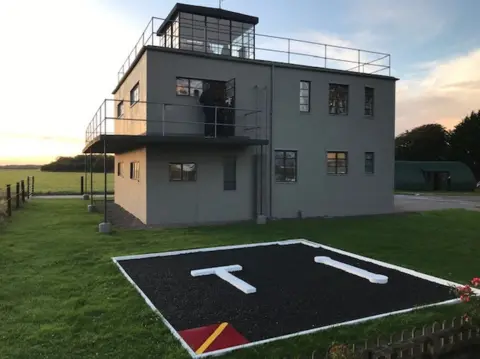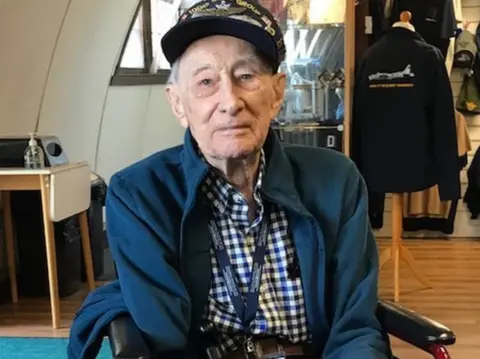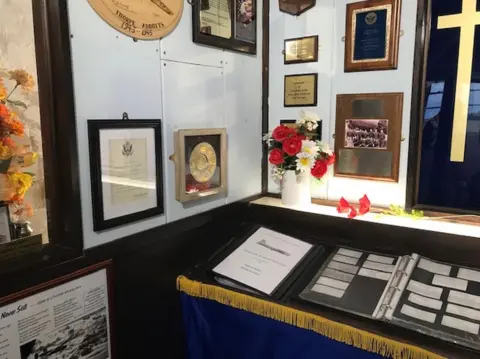Masters of the Air: The story behind the Apple TV drama
 Ian West/PA Media
Ian West/PA MediaThe story of a group of American World War Two airmen is about to be told in a television drama series featuring Hollywood star Austin Butler. But in a corner of the East Anglian countryside, where the group's B-17s began bombing raids on Nazi Germany, the men of "Bloody Hundredth" have long been celebrated.
Villagers in Thorpe Abbotts, Norfolk, realised more than 40 years ago that the young Americans who arrived on their doorsteps in June 1943 should not be forgotten.
Volunteers set up the 100th Bomb Group Memorial Museum in 1983.
Over the years, the museum has attracted thousands of visitors, including 100th Bomb Group veterans and their relatives, who have donated artefacts for displays.
But many more people will now learn about the exploits of the crews of the 100th Bomb Group for the first time when Masters of the Air, whose executive producers include director Steven Spielberg and actor Tom Hanks, airs on Apple TV on Friday.
 Simon Quilter/100th Bomb Group Memorial Museum
Simon Quilter/100th Bomb Group Memorial MuseumMuseum trustees have seen previews of Masters of the Air and expect the series to generate much more interest in the 100th and boost visitor numbers.
"In the 1970s we became concerned that what had happened in Thorpe Abbotts was in danger of being forgotten," explained Reg Wilson, the chair the 100th Bomb Group Museum trustees.
"A group of like-minded people got together and looked at creating some kind of memorial.
"The museum opened in 1983. Veterans came over from the United States for the opening.
"The aim was to remember these men and tell people what they did. The TV series will obviously tell their story to a much bigger audience."
He added: "I've seen a premiere and I was pleased with what I saw.
"The basic story is true. The characters were real people."
 Simon Quilter/100th Bomb Group Memorial Museum
Simon Quilter/100th Bomb Group Memorial MuseumAn American online military history tells how, in June 1942, the US Army Air Force activated the 100th, nearly three years after the outbreak of war.
Crews trained in Idaho and Utah, but their legend was born after they arrived at Thorpe Abbots airfield a year later.
Before June 1943 was out, crews had flown their first combat mission - and before long the group had been nicknamed the "Bloody Hundredth", because of the losses suffered.
"The [group] experienced several instances where it lost 12 of 13, or 13 of 15 aircraft on one mission," explains the United States Air Force's (USAF) online history.
"Just two months after entering the war, the group received its first Distinguished Unit Citation for its attack on the German aircraft factory at Regensburg on August 17 1943.
"The (group) lost nine crews on that raid alone."
Seven B-17s were missing in action after an attack on Bremen, the history explains.
Six out of 18 bombers had to abort over the North Sea during an attack on Munster.
Crews flew their last combat mission on 20 April 1945.
"During the 22 months that some 7,000 men and a few women of the 100th Bomb Group operated out of Thorpe Abbotts, the group flew 306 missions," adds the USAF history.
"The Air Force credited them with 8,630 sorties; dropped more than 19,257 tons of bombs plus 435 tons of food on humanitarian missions."
 Simon Quilter/100th Bomb Group Memorial Museum
Simon Quilter/100th Bomb Group Memorial MuseumA feature on the Imperial War Museum (IWM) website also tells the story of the 100th.
"The 100th Bomb Group is one of the most famous of World War Two," says the feature.
"The 100th was among an armada of American bomber and fighter groups to arrive in England to bolster the flagging formations of the Eighth Air Force. Eighth Air Force Bomber Command became the Eighth Air Force in February 1944 and oversaw the bombardment of strategic targets throughout Europe until 1945."
IWM curator Dr Hattie Hearn adds: "On the morning of 25th June 1943, B-17s of the 100th Bomb Group went to war for the first time.
"The target was the heavily defended submarine pens at Bremen in north-west Germany.
"This would not be a milk run.
"As the formation passed north of the Frisian Islands, three B-17s became lost in the heavy cloud cover and fell prey to prowling Luftwaffe fighters.
"The 100th had been in the air for a matter of hours and had already lost 30 men.
"It was the start of a legacy that would earn the bomb group the nickname the 'Bloody Hundredth'."
 Miriam McAlinden
Miriam McAlindenThe 100th lives on and is based in East Anglia.
In 1992, the unit returned to England, as the 100th Air Refueling Wing, to a new base at RAF Mildenhall in Suffolk.
American servicemen and women from the modern day 100th recently joined volunteers to watch a preview of Masters of the Air, some of which was filmed in the old town in Hemel Hempstead, Hertfordshire, at RAF Mildenhall.
'Comprehend'
Museum volunteers say several 100th veterans - former air and ground crew members - are still alive.
Former pilot John "Lucky" Luckadoo was the last to visit Thorpe Abbotts, in October at the age of 101.
"You have to remember, these were very young men who flew these missions," said Mr Wilson.
"Some few many missions while still in their teens.
"When we think of the problems we have in our daily lives, it's really difficult to comprehend what they had to face, and what they did."

Follow East of England news on Facebook, Instagram and X. Got a story? Email [email protected] or WhatsApp 0800 169 183
